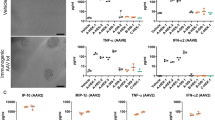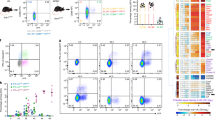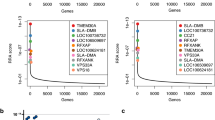Abstract
Sensing of viruses by dendritic cell (DC) pathogen recognition receptors (PRRs) represents a critical event during innate antiviral immune responses. Identification of these PRRs has often posed a problem due to difficulties in performing gene function studies in the naturally targeted hosts. Consequently, we developed a lentivirus (LV)-based strategy for specific gene knockdown in porcine DC. Short hairpin RNAs (shRNAs) were designed, targeting toll-like receptor 7 (TLR7) and the adaptor protein MyD88. As cellular targets, monocyte-derived DC (MoDC) and Flt3 ligand-induced DC (Flt3L-DC), DC precursors including monocytes and haematopoietic stem cells (HSCs) as well as plasmacytoid DCs (pDCs) were employed. Transduction efficiencies ranged from 40 to 95%. The LV-mediated shRNA delivery was functionally active, reducing TLR7 and MyD88 mRNA in MoDC and conventional Flt3L-DC, and blunting the responsiveness to TLR7 ligands in Flt3L-DC. Although infection of MoDC by the LV did neither influence MHC class II and CD80/86 expressions, nor cytokine responses, the infection of Flt3L-DC induced a phenotypic maturation. Furthermore, the interaction of the LV with pDC induced high levels of interferon-α. Taken together, these studies characterize the interaction of the LV with different DC subsets and demonstrate the suitability of LV-mediated small interfering RNA delivery for targeting PRR knockout for MoDC and conventional Flt3L-DC.
This is a preview of subscription content, access via your institution
Access options
Subscribe to this journal
Receive 12 print issues and online access
$259.00 per year
only $21.58 per issue
Buy this article
- Purchase on Springer Link
- Instant access to full article PDF
Prices may be subject to local taxes which are calculated during checkout






Similar content being viewed by others
References
Kawai T, Akira S . TLR signaling. Cell Death Differ 2006; 13: 816–825.
Banchereau J, Steinman RM . Dendritic cells and the control of immunity. Nature 1998; 392: 245–252.
Liu YJ . IPC: professional type 1 interferon-producing cells and plasmacytoid dendritic cell precursors. Annu Rev Immunol 2005; 23: 275–306.
Adah SA, Bayly SF, Cramer H, Silverman RH, Torrence PF . Chemistry and biochemistry of 2′,5′-oligoadenylate-based antisense strategy 1551. Curr Med Chem 2001; 8: 1189–1212.
Yoneyama M, Kikuchi M, Natsukawa T, Shinobu N, Imaizumi T, Miyagishi M et al. The RNA helicase RIG-I has an essential function in double-stranded RNA-induced innate antiviral responses. Nat Immunol 2004; 5: 730–737.
Sumpter Jr R, Loo YM, Foy E, Li K, Yoneyama M, Fujita T et al. Regulating intracellular antiviral defense and permissiveness to hepatitis C virus RNA replication through a cellular RNA helicase, RIG-I. J Virol 2005; 79: 2689–2699.
Alexopoulou L, Holt AC, Medzhitov R, Flavell RA . Recognition of double-stranded RNA and activation of NF-kappaB by Toll-like receptor 3 1750. Nature 2001; 413: 732–738.
Diebold SS, Kaisho T, Hemmi H, Akira S, Reis e Sousa C . Innate antiviral responses by means of TLR7-mediated recognition of single-stranded RNA. Science 2004; 303: 1529–1531.
Heil F, Hemmi H, Hochrein H, Ampenberger F, Kirschning C, Akira S et al. Species-specific recognition of single-stranded RNA via toll-like receptor 7 and 8. Science 2004; 303: 1526–1529.
Lund J, Sato A, Akira S, Medzhitov R, Iwasaki A . Toll-like receptor 9-mediated recognition of Herpes simplex virus-2 by plasmacytoid dendritic cells. J Exp Med 2003; 198: 513–520.
Krug A, Luker GD, Barchet W, Leib DA, Akira S, Colonna M . Herpes simplex virus type 1 activates murine natural interferon-producing cells through toll-like receptor 9. Blood 2004; 103: 1433–1437.
Hemmi H, Takeuchi O, Kawai T, Kaisho T, Sato S, Sanjo H et al. A Toll-like receptor recognizes bacterial DNA. Nature 2000; 408: 740–745.
Bauer S, Kirschning CJ, Hacker H, Redecke V, Hausmann S, Akira S et al. Human TLR9 confers responsiveness to bacterial DNA via species-specific CpG motif recognition. Proc Natl Acad Sci USA 2001; 98: 9237–9242.
Barton GM, Kagan JC, Medzhitov R . Intracellular localization of Toll-like receptor 9 prevents recognition of self DNA but facilitates access to viral DNA. Nat Immunol 2006; 7: 49–56.
Takeuchi O, Akira S . MyD88 as a bottle neck in Toll/IL-1 signaling. Curr Top Microbiol Immunol 2002; 270: 155–167.
Liew FY, Xu D, Brint EK, O'Neill LA . Negative regulation of toll-like receptor-mediated immune responses. Nat Rev Immunol 2005; 5: 446–458.
Hoebe K, Janssen EM, Kim SO, Alexopoulou L, Flavell RA, Han J et al. Upregulation of costimulatory molecules induced by lipopolysaccharide and double-stranded RNA occurs by Trif-dependent and Trif-independent pathways. Nat Immunol 2003; 4: 1223–1229.
Yamamoto M, Sato S, Mori K, Hoshino K, Takeuchi O, Takeda K et al. Cutting edge: a novel Toll/IL-1 receptor domain-containing adapter that preferentially activates the IFN-beta promoter in the Toll-like receptor signaling. J Immunol 2002; 169: 6668–6672.
Horng T, Barton GM, Flavell RA, Medzhitov R . The adaptor molecule TIRAP provides signalling specificity for Toll-like receptors. Nature 2002; 420: 329–333.
Hochrein H, O'Keeffe M, Wagner H . Human and mouse plasmacytoid dendritic cells. Hum Immunol 2002; 63: 1103–1110.
Guzylack-Piriou L, Balmelli C, McCullough KC, Summerfield A . Type-A CpG oligonucleotides activate exclusively porcine natural interferon-producing cells to secrete interferon-alpha, tumour necrosis factor-alpha and interleukin-12. Immunology 2004; 112: 28–37.
Hochrein H, Wagner H . Of men, mice and pigs: looking at their plasmacytoid dendritic cells [corrected]. Immunology 2004; 112: 26–27.
Hammond SM, Bernstein E, Beach D, Hannon GJ . An RNA-directed nuclease mediates post-transcriptional gene silencing in Drosophila cells. Nature 2000; 404: 293–296.
Zamore PD, Tuschl T, Sharp PA, Bartel DP . RNAi: double-stranded RNA directs the ATP-dependent cleavage of mRNA at 21–23 nucleotide intervals. Cell 2000; 101: 25–33.
Novina CD, Sharp PA . The RNAi revolution. Nature 2004; 430: 161–164.
Arthur JF, Butterfield LH, Roth MD, Bui LA, Kiertscher SM, Lau R et al. A comparison of gene transfer methods in human dendritic cells. Cancer Gene Ther 1997; 4: 17–25.
Naldini L, Blomer U, Gallay P, Ory D, Mulligan R, Gage FH et al. In vivo gene delivery and stable transduction of nondividing cells by a lentiviral vector. Science 1996; 272: 263–267.
Miyoshi H, Smith KA, Mosier DE, Verma IM, Torbett BE . Transduction of human CD34+ cells that mediate long-term engraftment of NOD/SCID mice by HIV vectors. Science 1999; 283: 682–686.
Summerfield A, Guzylack-Piriou L, Schaub A, Carrasco CP, Tache V, Charley B et al. Porcine peripheral blood dendritic cells and natural interferon-producing cells. Immunology 2003; 110: 440–449.
Lund JM, Alexopoulou L, Sato A, Karow M, Adams NC, Gale NW et al. Recognition of single-stranded RNA viruses by Toll-like receptor 7. Proc Natl Acad Sci USA 2004; 101: 5598–5603.
Naldini L, Blomer U, Gage FH, Trono D, Verma IM . Efficient transfer, integration, and sustained long-term expression of the transgene in adult rat brains injected with a lentiviral vector. Proc Natl Acad Sci USA 1996; 93: 11382–11388.
Han JJ, Mhatre AN, Wareing M, Pettis R, Gao WQ, Zufferey RN et al. Transgene expression in the guinea pig cochlea mediated by a lentivirus-derived gene transfer vector. Hum Gene Ther 1999; 10: 1867–1873.
Wolfgang MJ, Eisele SG, Browne MA, Schotzko ML, Garthwaite MA, Durning M et al. Rhesus monkey placental transgene expression after lentiviral gene transfer into preimplantation embryos. Proc Natl Acad Sci USA 2001; 98: 10728–10732.
Ikeda Y, Collins MK, Radcliffe PA, Mitrophanous KA, Takeuchi Y . Gene transduction efficiency in cells of different species by HIV and EIAV vectors. Gene Ther 2002; 9: 932–938.
Chinnasamy N, Chinnasamy D, Toso JF, Lapointe R, Candotti F, Morgan RA et al. Efficient gene transfer to human peripheral blood monocyte-derived dendritic cells using human immunodeficiency virus type 1-based lentiviral vectors. Hum Gene Ther 2000; 11: 1901–1909.
Schroers R, Sinha I, Segall H, Schmidt-Wolf IG, Rooney CM, Brenner MK et al. Transduction of human PBMC-derived dendritic cells and macrophages by an HIV-1-based lentiviral vector system. Mol Ther 2000; 1: 171–179.
Dyall J, Latouche JB, Schnell S, Sadelain M . Lentivirus-transduced human monocyte-derived dendritic cells efficiently stimulate antigen-specific cytotoxic T lymphocytes. Blood 2001; 97: 114–121.
Gruber A, Kan-Mitchell J, Kuhen KL, Mukai T, Wong-Staal F . Dendritic cells transduced by multiply deleted HIV-1 vectors exhibit normal phenotypes and functions and elicit an HIV-specific cytotoxic T-lymphocyte response in vitro. Blood 2000; 96: 1327–1333.
Dullaers M, Breckpot K, Van Meirvenne S, Bonehill A, Tuyaerts S, Michiels A et al. Side-by-side comparison of lentivirally transduced and mRNA-electroporated dendritic cells: implications for cancer immunotherapy protocols. Mol Ther 2004; 10: 768–779.
Rouas R, Uch R, Cleuter Y, Jordier F, Bagnis C, Mannoni P et al. Lentiviral-mediated gene delivery in human monocyte-derived dendritic cells: optimized design and procedures for highly efficient transduction compatible with clinical constraints. Cancer Gene Ther 2002; 9: 715–724.
Van Tendeloo VF, Snoeck HW, Lardon F, Vanham GL, Nijs G, Lenjou M et al. Nonviral transfection of distinct types of human dendritic cells: high-efficiency gene transfer by electroporation into hematopoietic progenitor- but not monocyte-derived dendritic cells. Gene Ther 1998; 5: 700–707.
Mitchell DA, Nair SK . RNA-transfected dendritic cells in cancer immunotherapy. J Clin Invest 2000; 106: 1065–1069.
Ponsaerts P, Van Tendeloo VF, Berneman ZN . Cancer immunotherapy using RNA-loaded dendritic cells 2022. Clin Exp Immunol 2003; 134: 378–384.
Ceppi M, Ruggli N, Tache V, Gerber H, McCullough KC, Summerfield A . Double-stranded secondary structures on mRNA induce type I interferon (IFN alpha/beta) production and maturation of mRNA-transfected monocyte-derived dendritic cells. J Gene Med 2005; 7: 452–465.
Sioud M . Induction of inflammatory cytokines and interferon responses by double-stranded and single-stranded siRNAs is sequence-dependent and requires endosomal localization. J Mol Biol 2005; 348: 1079–1090.
Judge AD, Sood V, Shaw JR, Fang D, McClintock K, MacLachlan I . Sequence-dependent stimulation of the mammalian innate immune response by synthetic siRNA. Nat Biotechnol 2005; 23: 457–462.
Sledz CA, Holko M, de Veer MJ, Silverman RH, Williams BR . Activation of the interferon system by short-interfering RNAs. Nat Cell Biol 2003; 5: 834–839.
Hornung V, Guenthner-Biller M, Bourquin C, Ablasser A, Schlee M, Uematsu S et al. Sequence-specific potent induction of IFN-alpha by short interfering RNA in plasmacytoid dendritic cells through TLR7. Nat Med 2005; 11: 263–270.
Beignon AS, McKenna K, Skoberne M, Manches O, DaSilva I, Kavanagh DG et al. Endocytosis of HIV-1 activates plasmacytoid dendritic cells via Toll-like receptor-viral RNA interactions. J Clin Invest 2005; 115: 3265–3275.
Del Corno M, Gauzzi MC, Penna G, Belardelli F, Adorini L, Gessani S . Human immunodeficiency virus type 1 gp120 and other activation stimuli are highly effective in triggering alpha interferon and CC chemokine production in circulating plasmacytoid but not myeloid dendritic cells. J Virol 2005; 79: 12597–12601.
Colonna M, Trinchieri G, Liu YJ . Plasmacytoid dendritic cells in immunity. Nat Immunol 2004; 5: 1219–1226.
Savarese E, Chae OW, Trowitzsch S, Weber G, Kastner B, Akira S et al. U1 small nuclear ribonucleoprotein immune complexes induce type I interferon in plasmacytoid dendritic cells through TLR7. Blood 2006; 107: 3229–3234.
Carrasco CP, Rigden RC, Schaffner R, Gerber H, Neuhaus V, Inumaru S et al. Porcine dendritic cells generated in vitro: morphological, phenotypic and functional properties 1653. Immunology 2001; 104: 175–184.
Overton WR . Modified histogram subtraction technique for analysis of flow cytometry data. Cytometry 1988; 9: 619–626.
Carrasco CP, Rigden RC, Schaffner R, Gerber H, Neuhaus V, Inumaru S et al. Porcine dendritic cells generated in vitro: morphological, phenotypic and functional properties. Immunology 2001; 104: 175–184.
McCullough KC, Schaffner R, Fraefel W, Kihm U . The relative density of CD44-positive porcine monocytic cell populations varies between isolations and upon culture and influences susceptibility to infection by African swine fever virus. Immunol Lett 1993; 37: 83–90.
Carrasco CP, Rigden RC, Schaffner R, Gerber H, Neuhaus V, Inumaru S et al. Porcine dendritic cells generated in vitro: morphological, phenotypic and functional properties. Immunology 2001; 104: 175–184.
Summerfield A, Horn MP, Lozano G, Carrasco CP, Atze K, McCullough K . C-kit positive porcine bone marrow progenitor cells identified and enriched using recombinant stem cell factor. J Immunol Methods 2003; 280: 113–123.
Summerfield A, McCullough KC . Porcine bone marrow myeloid cells: phenotype and adhesion molecule expression. J Leukoc Biol 1997; 62: 176–185.
Wiznerowicz M, Trono D . Conditional suppression of cellular genes: lentivirus vector-mediated drug-inducible RNA interference. J Virol 2003; 77: 8957–8961.
Zufferey R, Nagy D, Mandel RJ, Naldini L, Trono D . Multiply attenuated lentiviral vector achieves efficient gene delivery in vivo. Nat Biotechnol 1997; 15: 871–875.
Livak KJ, Schmittgen TD . Analysis of relative gene expression data using real-time quantitative PCR and the 2(-Delta Delta C(T)) Method. Methods 2001; 25: 402–408.
Acknowledgements
This work was supported by the Swiss Federal Office for Education and Science (Project 3100-068237/1). We thank Peter Zulliger and Daniel Brechbühl for care of the animals and their regular bleeding.
Author information
Authors and Affiliations
Corresponding author
Rights and permissions
About this article
Cite this article
Alves, M., Neuhaus, V., Guzylack-Piriou, L. et al. Toll-like receptor 7 and MyD88 knockdown by lentivirus-mediated RNA interference to porcine dendritic cell subsets. Gene Ther 14, 836–844 (2007). https://doi.org/10.1038/sj.gt.3302930
Received:
Revised:
Accepted:
Published:
Issue Date:
DOI: https://doi.org/10.1038/sj.gt.3302930
Keywords
This article is cited by
-
Infected erythrocyte-derived extracellular vesicles alter vascular function via regulatory Ago2-miRNA complexes in malaria
Nature Communications (2016)
-
The activation of TLR7 regulates the expression of VEGF, TIMP1, MMP2, IL-6, and IL-15 in Hela cells
Molecular and Cellular Biochemistry (2014)
-
The fungal T-2 toxin alters the activation of primary macrophages induced by TLR-agonists resulting in a decrease of the inflammatory response in the pig
Veterinary Research (2012)
-
Therapeutic targeting of the innate immune system in domestic animals
Cell and Tissue Research (2011)



